Ryan Hall's Blog, page 230
August 2, 2016
The Effects of Performance-Enhancing Drugs on an Athlete
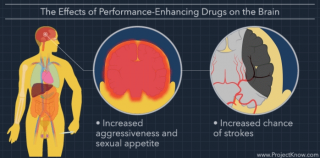
Unfortunately, competitive running has been riddled with rampant performance-enhancing drug (PED) use for years and only now have small efforts been made by the IAAF and national federations to clean up the sport. One thing that is rarely talked about is the ill effects PEDs can have on athletes. Although PEDs can give an athlete unfair advantages on the track, they also bring adverse health effects in the long run. Many of these substances cause cardiovascular conditions, organ damage, tumors and endocrine effects, all of which do more harm to the athlete than good.
ProjectKnow.com, a drug and alcohol addiction treatment resource, created a series of infographics to illustrate the effects of substances such as anabolic agents, peptide hormones, beta-2 antagonists, diuretics, stimulants, and narcotics on the body to explore how performance-enhancing drugs may actually impede performance. Scroll through the images to see what negative effects PEDs can have on the different parts of an athlete’s body. (Numerous treatment programs are available–for you or someone close to you struggling under the weight of the compulsion to continue using drugs of any kind. Call to speak with a confidential treatment support advisor at 888-287-0471 for more information.)
Photo Gallery
1 of {count}
Back to Start
View Larger Image
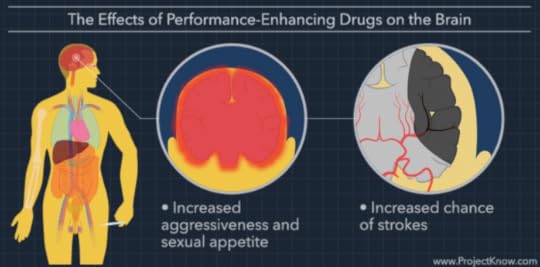
Brain
Anabolic agents and peptide hormones can severely affect the brain. Anabolic agents such as testosterone promote muscle growth in the body. Using them can lead to increased aggressiveness and sexual appetite – also known as ’roid rage.' Post-steroid withdrawal can result in depression and, in some cases, suicidal ideation. Peptide hormones like erythropoietin (EPO) control the production of red blood cells that carry oxygen. EPO doping essentially thickens the blood—its use without close medical supervision can lead to an increased risk of blood clots and strokes.
Stimulants, such as caffeine, amphetamines, and methamphetamine, are used to trigger responses that allow the body and mind to perform with elevated levels of focus and energy. This increase in energy can then lead to nervousness and irritability. Furthermore, stimulants in the amphetamine family can have numerous pathological cardiovascular effects.
Certain substances also produce a false sense of invincibility, which can lead to further injury. Both stimulants and narcotics can cause dependence and addiction as well, which can further impair an athlete’s ability to perform.
View Larger Image
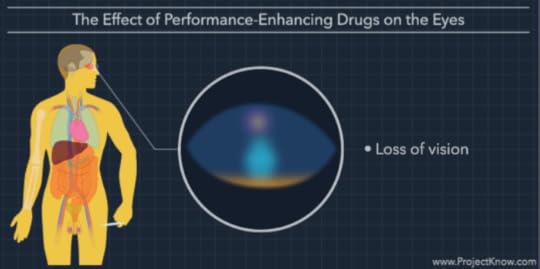
Eyes
Human growth hormones (hGH) occur naturally in the body. They stimulate growth as well as cell production and regeneration, and they are often used in a medical setting to aid those born prematurely. An excess of hGH can lead to the development of pituitary adenoma, a slow-growing tumor arising from cells in the pituitary gland. A large pituitary adenoma can cause loss of vision when the tumor grows upward in the brain cavity and compresses the optic chiasm. Blurry vision can also occur if the tumor grows forward and suppresses an optic nerve.
Pituitary tumors and subsequent vision loss are serious side effects of misusing hGH. These represent a startling extreme of the unexpected health ramifications that abuse of performance enhancers can have. In many cases, the injury that we do to ourselves with substance abuse—performance enhancers or otherwise—follows a more indolent course or, at least, is less apparent to the user.
View Larger Image
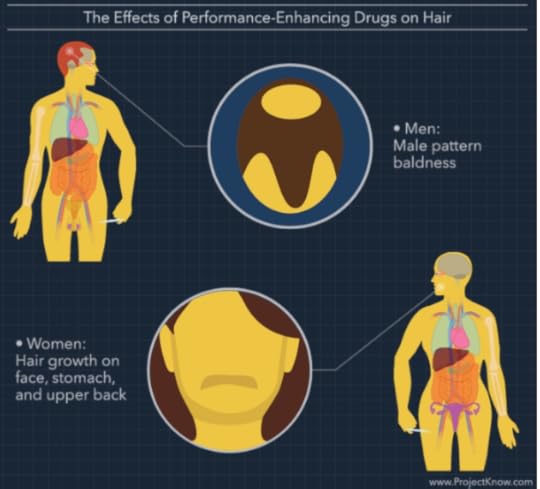
Hair
While anabolic agents such as testosterone promote muscle growth, they also have endocrine effects. Testosterone is the main hormone in humans that produces male primary and secondary sex characteristics, like vocal cords, testicles, and body hair. An increase in testosterone in women can lead to an increase in these male characteristics, particularly hair growth on the face, stomach, and upper back.
Anabolic agents can also exaggerate male pattern baldness—in both males and females! The scalp has a high amount of androgen receptors, and male pattern baldness can be linked to anabolic agents binding to these receptors. Genetic factors can also increase susceptibility in certain individuals.
View Larger Image
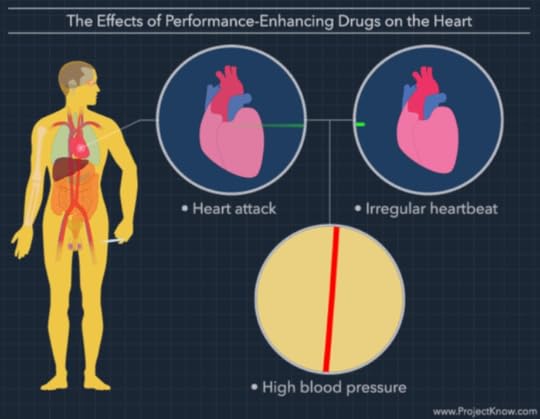
Heart
Peptide hormones such as EPO increase the red blood cell count, which raises the percentage of the blood composed of red blood cells. Side effects of this include the thickening of the blood, which requires the heart to pump harder and can lead to a heart attack.
Stimulants can also cause an increase in heart rate and blood pressure. Beta-2 antagonists, drugs used to treat respiratory ailments that have effects similar to stimulants, can cause heart palpitations. Misuse of hGH can also lead to high blood pressure and, in some cases, heart failure. Narcotics, on the other hand, can decrease the heart rate, and diuretics—drugs that expel water from the body, often used by athletes who need to meet certain weight restrictions—can cause a drop in blood pressure.
View Larger Image
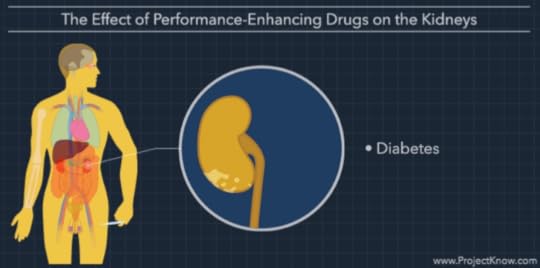
Kidneys
A prolonged excess of hGH can lead to a functional pituitary adenoma and, subsequently a condition called acromegaly– which can cause enlarged hands, feet, and other areas of the body. This can additionally cause insulin resistance and, in some cases, Type 2 diabetes. When the body resists insulin—a hormone that regulates the movement of sugar into cells—the body loses an important source of fuel. This dysfunction in blood sugar control can lead to fatigue and weight loss, both of which decrease an athlete’s performance.
View Larger Image
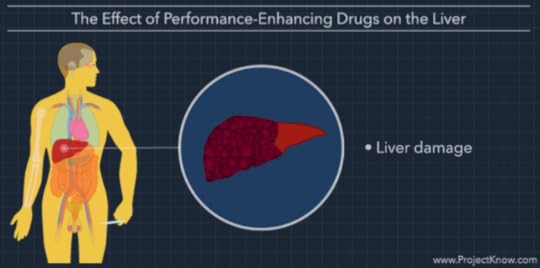
Liver
High doses of anabolic agents can cause liver damage. The steroids, because of modifications that make them more bioavailable and longer-lasting, are metabolized in the digestive system, meaning they go through the liver. The anabolic agents can lead to a range of damage: everything from minor enzyme elevations to hepatic peliosis—blood-filled cavities throughout the liver—as well as liver tumors (sometimes benign, sometimes malignant).
This damage to the liver can be serious, although it is often reversible with cessation of the steroid. The state of our liver health generally provides a good overall indication of how careful we are with what we place into our bodies, including any toxic substances that we ingest.
View Larger Image
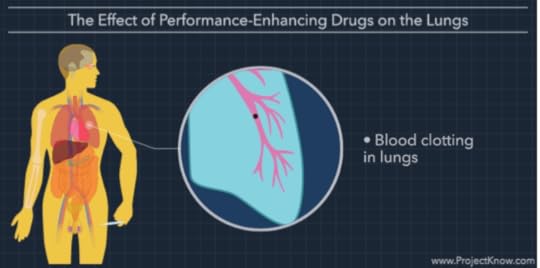
Lungs
While the blood-thickening properties of peptide hormones such as EPO can lead to heart attacks, thickened blood can also raise the body’s risk for blood clots, which can lead to pulmonary embolism—a blockage in the artery of the lungs, usually caused by a blood clot in the deep veins of the leg. Termed deep venous thromboses (DVTs), these clots can be quite large, and can break loose—traveling to and becoming stuck in the pulmonary blood vessels, preventing normal circulation and oxygen exchange in the portion of lung that is affected.
Dehydration caused by water-expelling diuretics can also lead to blood clots. Without enough fluids, the blood vessels narrow and the blood thickens, which—again—can lead to blood clots.
View Larger Image
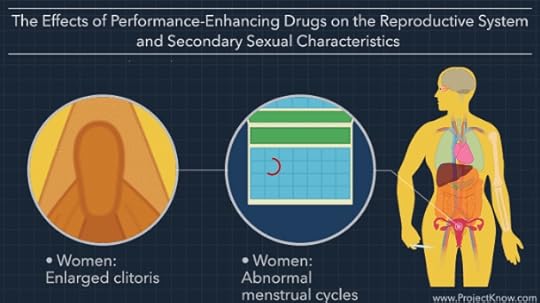
Female Reproductive System
Anabolic agents bind glucocorticoid, progesterone, and estrogen receptors, leading to altered hormone levels. In women, an increase in testosterone increases male primary and secondary sex characteristics, which can lead to the deepening of the voice, the growth of the clitoris, and abnormal menstrual cycles.
View Larger Image
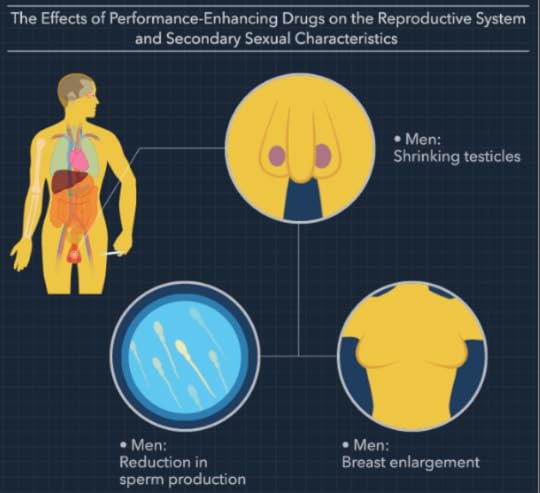
Male Reproductive System
Anabolic agents bind glucocorticoid, progesterone, and estrogen receptors, leading to altered hormone levels. In males, an altered level of testosterone often means the development of breast tissue and inhibited function of the testes, as well as a reduced sperm count.
View Larger Image
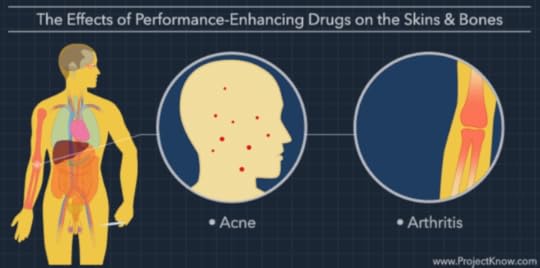
Skin and Bones
Steroids can affect the skin and the bones. Skin—especially the face and scalp—has a high level of androgen receptors. Anabolic agents are known to prompt an increase in sebum production, which can cause cystic acne. Anabolic agents also lead to a premature closure of the growth centers of bones in adolescents, which can lead to stunted growth.
As mentioned, excess hGB can lead to pituitary adenoma and acromegaly. Acromegaly causes changes in the body that lead to disfigurement. Part of these changes involves a thickening of cartilage, which can lead to debilitating arthritis.

More Galleries
The post The Effects of Performance-Enhancing Drugs on an Athlete appeared first on Competitor.com.
New Nike+ App Connects Consumers to Gear, Events, Experts
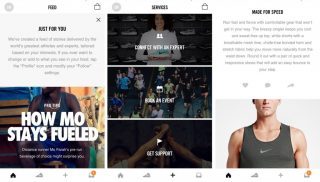
The new Nike+ app allows consumers to connect to expert advice as well as Nike's online store.
In a growing digital push, Nike released the new Nike+ app on Aug. 2. It joins and seamlessly connects to Nike’s other apps Nike+Running, Nike+Training Club, Nike+ Fuel and Nike+SNKRS, creating a central hub for fitness, expert guidance, shopping, news and events. The Nike+ app, available for iPhone and Android platforms, can be highly personalized to your favorite sports, Nike collections and even to your performance levels as measured by the other Nike apps.
Nikki Neuburger, Vice President, Global Brand Running at Nike, and Bob Bennet, General Manager of Nike+, said the app has been positioned to be the one place, across all categories, for athletes to connect with the best of Nike, its products, experts and events. Think of it as the Nike’s “all access pass” to all things digital.
The new Nike+ app includes:
“Reserved for You” personalized product suggestions, ahead of general release and adapting to preferences over time
Curated Pro-Tips, in the app’s feed, based on your sports, interests and performance level
Access by phone, in person at Nike stores, or via chat to Nike+Experts who can help you reach your goals and chose gear
Direct in app connection to Nike+Running and Training Club events around the world
Scan-friendly pass for personalized in store service and event check-in
We gave the app an early test and were pleasantly surprised by the product selections and the expert tips. The app clearly understood we were a frequent user of Nike+Running with a preference for faster-paced mileage. It suggested Olympic champion Mo Farah’s training kit of an AeroReact singlet, AeroSwift shorts and Pegasus 33 as a collection to consider. (I actually own the AeroReact singlet and AeroSwift shorts.) At the Expert Tip of the day, I was surprised to learn that Mo doesn’t just like coffee in the morning but also has a cup when he is cooling down after his workouts.
To help create compelling engaging content and mobile experiences for athletes and to accelerate its digital connection to consumers, Nike also announced that it will open its first digital studio in New York City, staffed with experienced tech entrepreneurs formerly of Virgin Mega.
In other news, Nike will be updating its popular Nike+Running app this fall, making it more like Nike+Training Club. It will be renamed Nike+Run Club. It will have more and improved data fields, and an emphasis on extensive training and coaching plans. We were most excited to hear that a chosen training plan will adapt based on your results along the way and that the app will offer extensive new flexibility in sharing results with friends.
The post New Nike+ App Connects Consumers to Gear, Events, Experts appeared first on Competitor.com.
How to Watch Track & Field at the Rio Olympics
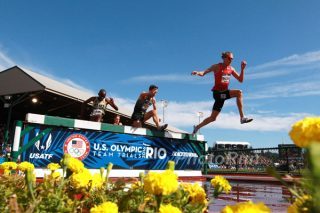
American Evan Jager soars over the water pit en route to winning the 3,000-meter steeplechase at the U.S. Olympic Trials on July 8 in Eugene, Ore. Photo: PhotoRun.net
There’s nothing quite like track and field competition in the Olympics. From the 100 meters to the marathon, every event is full of drama, grit, heartbreak and celebration.
The good news for track and field fans is that the 2016 Summer Olympics will feature more live broadcasting of events than ever before. The networks and digital platforms of NBC Universal will present an unprecedented 6,755 hours of programming from Aug. 5–21, and hopefully that means fewer cutaways from key track races longer than the 1,500m.
Although initial Olympic competition begins on Aug. 3, the opening ceremony of the Rio Olympics will air on NBC via a one-hour tape delay at 8 p.m. ET on Friday, Aug. 5. Track and field competition will be held every day between Aug. 12-21.
Almost all of NBC’s track and field coverage will be broadcast on NBC and NBC Sports Network, but plenty of live action and videos can also be found at NBCOlympics.com and the NBC Sports app on a smartphone or tablet. The women’s marathon is slated for 8:30 a.m. ET on Aug. 14, while the men’s marathon will be held a week later at 8:30 a.m. ET on Aug. 21.
The Rio Olympic Games conclude on Aug. 21, with the closing ceremony being shown live on NBC beginning at 6 p.m. ET.
Here are a few more resources to help you follow the Olympic action from Rio:
RELATED: Complete 2016 Olympic Track & Field Schedule
RELATED: Complete NBC Sports Olympic Schedule (All Sports)
RELATED: NBC Sports Olympic Track & Field Page
The post How to Watch Track & Field at the Rio Olympics appeared first on Competitor.com.
August 1, 2016
Photos: Running 453 Miles of the Pacific Crest Trail in Record Time
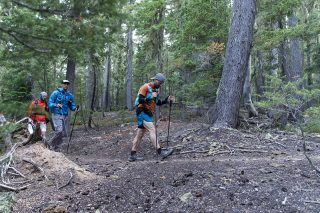
From July 16-24, Yassine Diboun and Scott Loughney successfully ran and hiked 453 miles along the Pacific Crest Trail, crossing the entire state of Oregon from the Oregon/California border to the Oregon/Washington border with help from a tireless support crew. In the process, they raised money for three charities and set a new supported fastest known time (FKT) on the route of eight days, 12 hours and 5 minutes, beating the previous record of eight days and 19 hours held by Joe McConaughy. (They originally aimed to beat the self-supported FKT of 7 days and 22 hours set by Brian Donnelly in 2013, but had to quickly adjust to the new goal in the final days of the run.)
Along with Diboun and Loughney, fellow runner Travis Liles who had set out with them on Day 1 of the run had to call it quits on Day 4 after covering 215 miles on the PCT. Tendonitis had developed on the top of his foot and ankle, making it excruciatingly painful for him to even maneuver his foot up or down. “It was a very crushing feeling to drop,” Liles says. “However, I knew there was still work to be done so I gave myself a moment to let it all sink in, accept that my role of a runner was gone, and then I turned my attention to making sure we set Yassine and Scott up for success from that point forward.”
Recapping the entire experience, Diboun wrote on his Facebook, “(It) almost broke us down physically, mentally and emotionally. We constantly had to rally and lift our spirits as we traversed rugged terrain, snow, vicious mosquitos, lots of trees blocking the trail, and we dealt with the worst sleep deprivation I’ve ever experienced. I cried almost every day on the trail. And yet it was such a cleansing and primal experience. This adventure taught us so much, brought so many people together for a great cause and challenged us to the brink that it will likely take a long time to process it all.”
Check out the day-by-day photo diary of their adventure below and read more about the run and the story of how it came together here.
Photos: Chris Low
Photo Gallery
1 of {count}
Back to Start
View Larger Image
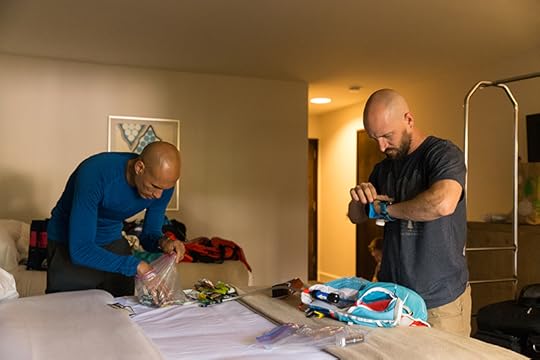
Day 0
The night before the start of their FKT attempt, Yassine and Travis pack and prep in their hotel room in Ashland, Ore.
View Larger Image
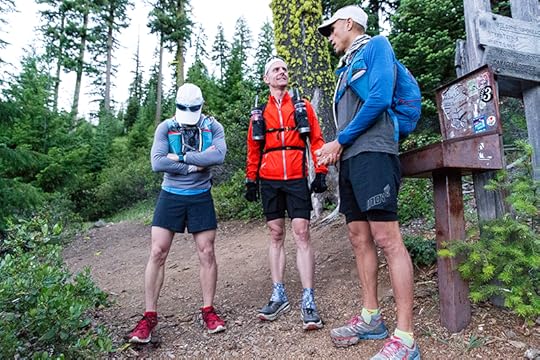
Day 1
Yassine (right) gives a pep talk to Scott (middle) and Travis reminding them that they are ready and the FKT attempt starts now at the Oregon/California border of the PCT.
View Larger Image

Day 3
Scott, Yassine and Travis run the Crater Lake rim trail with pacer Mike.
View Larger Image

Day 4
Scott, Yassine, and Travis run through a huge field of grey, dead trees just south of Windigo Pass.
View Larger Image

Day 4
Travis leads Yassine and Scott into the Summit Lake aid stop. At the end of Day 4, Travis makes the decision to drop out due to an injury.
View Larger Image

Day 5
At Elk Lake, Yassine has his coffee and a leg massage by Karen Peterson, the resident medical consultant.
View Larger Image

Day 5
At their next support stop, Charleton Lake, Scott cools himself off.
View Larger Image

Day 5
Yassine leads Scott and pacer Jason Eads on the way into McKenzie Pass.
View Larger Image
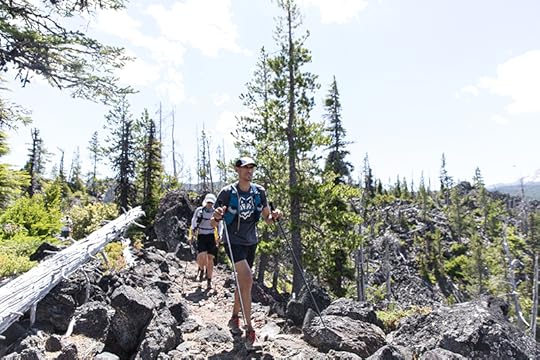
Day 5
Yassine leads Scott and pacer Jason Eads on the way into McKenzie Pass.
View Larger Image
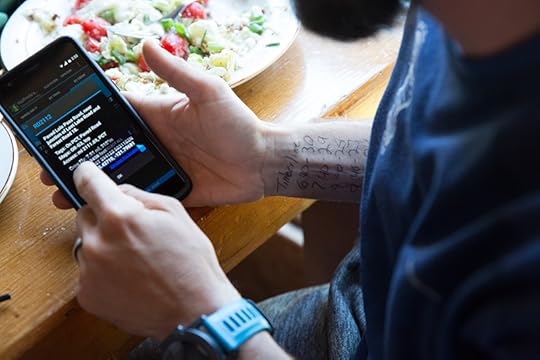
Day 6
During some crew down time, Travis uses the half-mile PCT app and does some math. He writes notes on his arm so he can show Scott and Yassine in a very simple manner what they will need to do in order to get the FKT.
View Larger Image

Day 7
After a long hard night out on the trail, Yassine and Scott needed sleep. At 3:30 a.m. they made it to the trailer for aid and sleep. They knew the overall FKT was out of reach and decided to sleep for a few hours and shoot for the supported FKT. They ran into the Timberline Lodge parking lot that evening for some food and a short rest before heading out to Lolo Pass.
View Larger Image

Day 7
In the Timberline Lodge parking lot, Yassine celebrates the fact that they have made it this far, to Portland's backyard, Mount Hood. They found a wig out on the trail that turned out to belong to a friend who was there to see them.
View Larger Image

Day 7
During their Timberline Lodge rest stop, Scott reclines with a blanket before his brother Devin gets to work on his feet.
View Larger Image

Day 8
At Lolo Pass Devin carries Scott on his back from the trailer to the station where he will prepare his feet for their last day.
View Larger Image
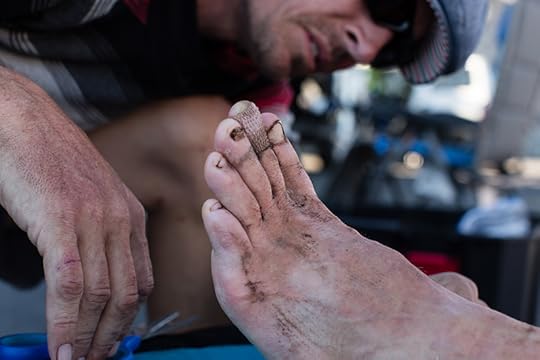
Day 8
Devin inspecting Scott's foot. Scott had such bad blisters that Devin became his personal foot mender.
View Larger Image

Day 8
In the final hours of the effort, Yassine leads Scott and their pacer (Devin) down the hill and into Cascade Locks.
View Larger Image

Day 8
At the finish, Yassine goes in for a hug with current overall FKT holder Brian Donnelly. Yassine first attempted the FKT with Donnelly in 2013 but had to drop due to an injury.
View Larger Image

Day 8
After 8 days, 12 hours and 5 minutes of running the Oregon PCT, Devin plays the guys some violin. They earned it.

More Galleries
The post Photos: Running 453 Miles of the Pacific Crest Trail in Record Time appeared first on Competitor.com.
July 28, 2016
Gear We Love: July
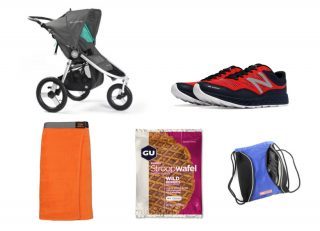
From a roller made out of rope to speedy strollers, the editors share their favorite gear picks of the month:
Photo Gallery
1 of {count}
Back to Start
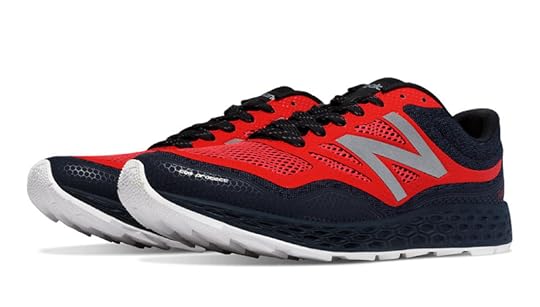
New Balance Fresh Foam Gobi Trail, $95
New Balance took the super fun chassis of the Fresh Foam Zante and added a slightly burlier upper and a toothier outsole, and renamed it the Gobi. It’s a great hybrid shoe that rides nicely on roads and easy trails. It’s a great value, it’s not too heavy at 9.3 ounces, and it's like a Swiss army knife of a shoe for runners who run on different surfaces—or at least those who want some versatility without having to buy multiple pairs. —Adam Elder, managing editor
View Larger Image
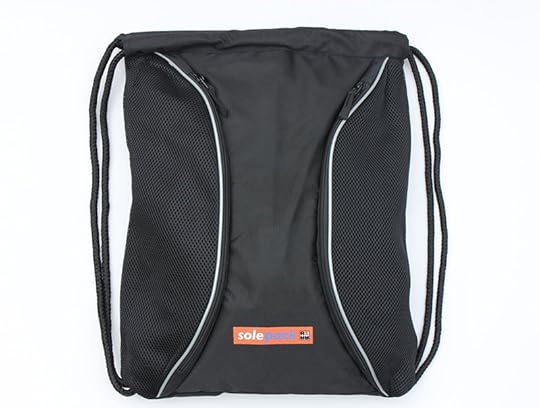
Solepack GRF Black, $25
The Solepack GRF bag is an upgrade to the classic drawstring bag made of cheap plastic that falls apart within months. It has two outer mesh zip pockets for storing shoes—the mesh helps prevent the smelly odor of your shoes from sticking to the bag. Plus, the pockets are roomy enough to fit up to a men's size 14! Even the bag itself is made of a sturdy, thick synthetic material and is big enough to fit gym clothes, personal items, a water bottle and some post-run fuel. —Emily Polachek, associate editor
View Larger Image
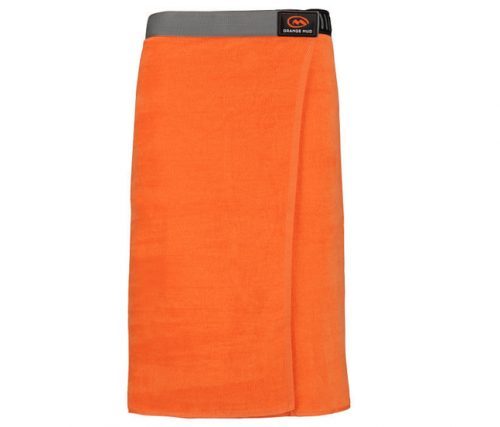
Orange Mud Transition Towel and Seat Wrap, $40
Trail runners aren't known to be modest, but that doesn't mean you want to expose yourself in a trailhead parking lot if you're changing after a run. The Transition Towel and Seat Wrap can serve multiple purposes, but most notably as a way to pull off your sweaty shorts during a quick change after a run. It's like a terry cloth towel with a built-in adjustable belt that wraps around you above your waist, allowing runners of all shapes and sizes to discreetly change out their shorts for post-run clothing. Even if you don't change in the parking lot, it can be used as a temporary seat cover so sweat and mud from the trails won't soak into your car seats. —Brian Metzler, editor-in-chief
View Larger Image

Gurilla Ground Roller 12", $50
The Gurilla Ground Roller is unlike any massage/recovery roller you'll see out there. Its most distinctive feature is the mold resistant polypropylene rope wrapped around a sturdy, hollow plastic barrel. Why rope? According to the creators, rope withstands use over time unlike foam or plastic rollers that break down after a few years of use. More importantly, the rope allows the roller to grip to myofascial tissue more easily without sticking to skin and pulling out hairs, increasing overall blood flow. Compared to foam rollers, the rope had a smoother and softer feel to it, but still maintained its firmness on working out tight muscles. The 12-inch version is also great for travel and comes with a carabiner to clip onto your gym bag. —Emily Polachek, associate editor
View Larger Image
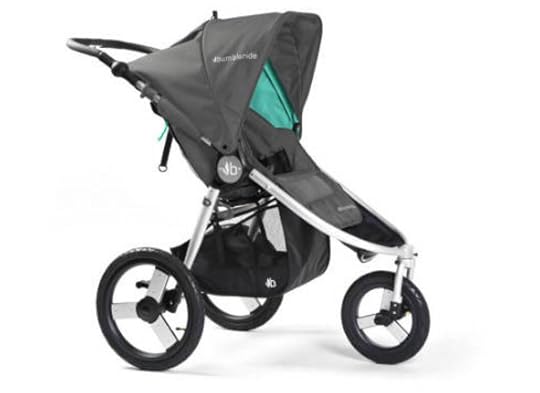
Bumbleride Speed, $549
This new jogging stroller has about everything one could possibly want or need to go running with your kid. It folds and unfolds easily, has a great suspension, plenty of pockets and storage, a generous canopy that unfolds to block out the sun from almost any angle and time of day, a magnetic peekaboo window to keep a quick eye on your passenger, a breakaway seatbelt design that allows quick exits when meltdowns happen, water-bottle holders and thoughtful touches like a concealed, compact air pump that’s there if you need it. Maybe the coolest feature, though, is in the front fork. You can make it swivel fully, or swivel only partially so that it doesn’t dangerously spin out—or, it can lock forward for when you’re running faster speeds. And while other fixed-front-wheel jogging strollers will frustratingly veer left or right, this stroller’s fork has a micro-adjustment feature to make it roll straight and true with the turn of a knob. It rides solidly and smoothly, and is a rare pleasure to run with among jogging strollers. The only thing conspicuously absent is a handbrake; Bumbleride says it was kept off in order to save weight. —Adam Elder, managing editor
View Larger Image
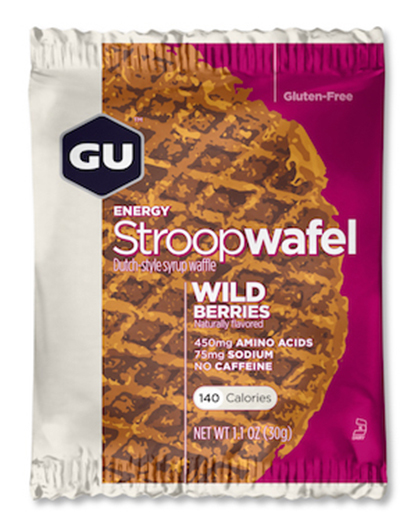
GU Energy Stroopwafel, $22.50 for box of 16
Sometimes during or after a long trail run, you just don't want to suck down another gel. Sometimes you want real food you can taste, chew and swallow. Enter the new GU Energy Stroopwafels, a soft and chewy treat modeled after Dutch-style syrup waffles. Available in three flavors (Salted Chocolate, Wild Berries, Salted Caramel), they provide similar nutritional qualities as a GU Energy Gel. Although nutritional breakdown varies by flavor, each one provides about 21g of carbs and 140–150 calories, plus 6g of fat and 150mg of sodium—ideal for a performance-oriented pick-me-up during a trail run or a pre-run breakfast snack. GU says it contains quality carbohydrates (complex and simple carbohydrates provide immediate and long-lasting energy) essential amino acids (which prevent mental fatigue and repair muscle damage during long-duration activities), and electrolytes (which replenish what’s lost when you sweat). Energy Stroopwafels come in boxes of 16, individually wrapped, at $22.50 for gluten full and $24 for gluten free. —Brian Metzler, editor-in-chief
Related Galleries

Gear We Love: June 2016
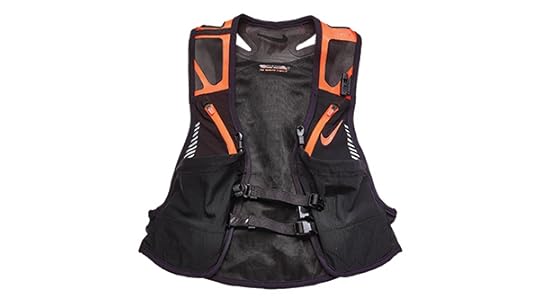
Gear We Love: May 2016

Gear We Love: April 2016

Gear We Love: March 2016

More Galleries
The post Gear We Love: July appeared first on Competitor.com.
July 27, 2016
Footwear Insights from New Balance Shoe Savant Claire Wood
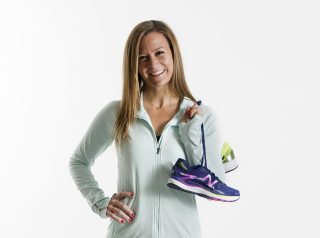
Photo: Yoon S. Byun
From her days working in a local run specialty shop through high school and her collegiate track career, Claire Wood has always been intrigued by running shoes. After her competitive career ended at James Madison University, Wood scored a tech rep position with Mizuno—basically a regional brand ambassador job to help with sales and events in running stores—that gave her some initial insights into the running industry. The now 34-year-old from Boston got into the product side of the business while working at Brooks a few years later, then she moved on to New Balance, where she’s been for the past seven and a half years, and is currently senior product manager for performance running footwear.
What do you do in your role at New Balance?
I work with designers, developers and engineers and bring together all aspects of global running market needs. I have to know what’s going on in the performance running market and share that with our team. Our goal is to be on the leading edge of trends and deliver shoes our customers want, when they want them. For shoes, we work with about an 18-month window from inception to reality.
You ran in college, now you work for New Balance. How does running fit into your life?
Running is a huge part of my life. I run five days a week. Always have. Running is almost twofold for me. It keeps me grounded and focused for the day. Then other times I’m really focusing on the footwear. I may not be running competitively anymore, but I do have a personal rule: If I see someone running in a non-running brand on the Charles River trail, I have to pass them.
What trends have made a big impact in running shoes?
More people now understand the importance of mixing up the shoes they wear throughout the week. The idea that you shouldn’t run the exact same pace or do the exact same workout every day because it isn’t good for your body also applies to footwear. The position your foot is in, the materials your foot engages with underfoot—it’s good to mix it up.
What have you learned about making shoes with newer, simpler, cleaner designs?
They are some of the most costly and challenging for us to make! It’s tricky and complicated and there are always so many moving parts necessary to make innovative, enhanced products. We don’t add pieces just to add pieces. Our goal is for all of our shoes to have smoothness from top to bottom, plus a truly fluid and uninterrupted ride. Marrying science and math—essentially looking at data at a microscopic level—with a strong sense of form and aesthetics is what brings New Balance styles to life.
How does 3D printing fit into shoe design?
We were the first to make a 3D running product available to runners in April. But it isn’t just that “we made a 3D printed shoe.” We started with it in 2011 by printing track plates for our professional runners. What we learned during the process inspired Fresh Foam. We also use 3D printing to help inform macro-level design changes.
How do athletes contribute to product design?
Our athletes are official wear testers and their feedback plays an important role in the process for our design team. We stay close to them during hard training cycles and talk to them, but it often happens through something like a random text, email or a picture with comments that make a big difference. That level of athlete is putting shoes through incredibly strenuous activities. If they can work for them, we believe they can work for anybody.
What does New Balance have in the works for the Olympics?
As a brand we aren’t allowed to mention that specific event, but you will see some preview products of our Spring 2017 track and field line at key races this summer. We have updates to the MD800 and the LD5000, our middle and long distance shoes. Our sprint shoe, the Vazee Sigma is also amazing and has a really unique closure that we developed with Boa. It all ties in with our new race kit through a cool color story.
What drives you nuts about shoe reviews?
If we get a bad review for a shoe that running specialty stores and our customers love, it makes me think the reviewer wasn’t in the right shoe for them. We absolutely do not go to market with a product that has not been deemed ready by an incredible amount of testing. We’ve gotten a lot of awards lately, and those are consistent with market data, sales and our research.
Do you have a favorite shoe?
I have a soft spot in my heart for all of them. But, Fresh Foam 1080 has been a really symbolic style to me, from teamwork to design. I look at that shoe and don’t see any BS. I love shoes that look good and make running better.
The post Footwear Insights from New Balance Shoe Savant Claire Wood appeared first on Competitor.com.
Q&A with New Balance’s Shoe Savant, Claire Wood

Photo: Yoon S. Byun
From her days working in a local run specialty shop through high school and her collegiate track career, Claire Wood has always been intrigued by running shoes. After her competitive career ended at James Madison University, Wood scored a tech rep position with Mizuno—basically a regional brand ambassador job to help with sales and events in running stores—that gave her some initial insights into the running industry. The now 34-year-old from Boston got into the product side of the business while working at Brooks a few years later, then she moved on to New Balance, where she’s been for the past seven and a half years, and is currently senior product manager for performance running footwear.
What do you do in your role at New Balance?
I work with designers, developers and engineers and bring together all aspects of global running market needs. I have to know what’s going on in the performance running market and share that with our team. Our goal is to be on the leading edge of trends and deliver shoes our customers want, when they want them. For shoes, we work with about an 18-month window from inception to reality.
You ran in college, now you work for NB. How does running fit into your life?
Running is a huge part of my life. I run five days a week. Always have. Running is almost twofold for me. It keeps me grounded and focused for the day. Then other times I’m really focusing on the footwear. I may not be running competitively anymore, but I do have a personal rule: If I see someone running in a non-running brand on the Charles River trail, I have to pass them.
What trends have made a big impact in running shoes?
More people now understand the importance of mixing up the shoes they wear throughout the week. The idea that you shouldn’t run the exact same pace or do the exact same workout every day because it isn’t good for your body also applies to footwear. The position your foot is in, the materials your foot engages with underfoot—it’s good to mix it up.
What have you learned about making shoes with newer, simpler, cleaner designs?
They are some of the most costly and challenging for us to make! It’s tricky and complicated and there are always so many moving parts necessary to make innovative, enhanced products. We don’t add pieces just to add pieces. Our goal is for all of our shoes to have smoothness from top to bottom, plus a truly fluid and uninterrupted ride. Marrying science and math—essentially looking at data at a microscopic level—with a strong sense of form and aesthetics is what brings New Balance styles to life.
How does 3D printing fit into shoe design?
We were the first to make a 3D running product available to runners in April. But it isn’t just that “we made a 3D printed shoe.” We started with it in 2011 by printing track plates for our professional runners. What we learned during the process inspired Fresh Foam. We also use 3D printing to help inform macro-level design changes.
How do athletes contribute to product design?
Our athletes are official wear testers and their feedback plays an important role in the process for our design team. We stay close to them during hard training cycles and talk to them, but it often happens through something like a random text, email or a picture with comments that make a big difference. That level of athlete is putting shoes through incredibly strenuous activities. If they can work for them, we believe they can work for anybody.
What does New Balance have in the works for the Olympics?
As a brand we aren’t allowed to mention that specific race, but you will see some preview products of our Spring 2017 track and field line at key races this summer. We have updates to the MD800 and the LD5000, our middle and long distance shoes. Our sprint shoe, the Vazee Sigma is also amazing and has a really unique closure that we developed with Boa. It all ties in with our new race kit through a cool color story.
What drives you nuts about shoe reviews?
If we get a bad review for a shoe that running specialty stores and our customers love, it makes me think the reviewer wasn’t in the right shoe for them. We absolutely do not go to market with a product that has not been deemed ready by an incredible amount of testing. We’ve gotten a lot of awards lately, and those are consistent with market data, sales and our research.
Do you have a favorite shoe?
I have a soft spot in my heart for all of them. But, Fresh Foam 1080 has been a really symbolic style to me, from teamwork to design. I look at that shoe and don’t see any BS. I love shoes that look good and make running better.
The post Q&A with New Balance’s Shoe Savant, Claire Wood appeared first on Competitor.com.
July 26, 2016
Shoe of The Week: New Balance Vazee Pace 2
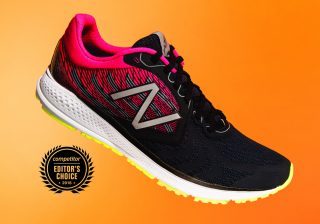
Fit/Feel/Ride: Too many companies launch a great shoe only to mess up a good thing by making too many changes on round two. Fortunately, New Balance didn’t do more than tweak the already-excellent Vazee Pace, only changing the bootie-constructed upper’s woven mesh with no-sew overlays, partly cosmetic and partly to increase the support. The second edition also boasts enhanced durability with added blown rubber to the REVlite midsole. Otherwise, it is still the utilitarian, uptempo trainer that offers a responsive enough performance, which makes it a good half marathon/marathon racer too. Our test team liked the Vazee Pace 2 for its fit and performance in a variety of workouts. And what’s not to like about the $110 price tag? That would be a bargain even for a shoe not as superlative as this one. The only thing a few of our testers complained about was that the interior bootie construction being a bit too snug for higher-volume feet—so definitely try these on in the shop. Otherwise, this shoe is a winner in our book—namely the winner of our Editor’s Choice award for our Fall 2016 Road Running Shoe Buyer’s Guide.
This is the shoe for you if … You’re looking for an energetic, well-cushioned shoe that can more than hold its own running long or running fast.
Price: $110
Weights: 9.6 oz. (men’s), 7.9 oz. (women’s)
Heel-to-toe Offset: 6mm; 24mm (heel), 18mm (forefoot)
Info: NewBalance.com
RELATED: Shoe of The Week—Brooks Ghost 9
The post Shoe of The Week: New Balance Vazee Pace 2 appeared first on Competitor.com.
Active Launches New Social Workout App
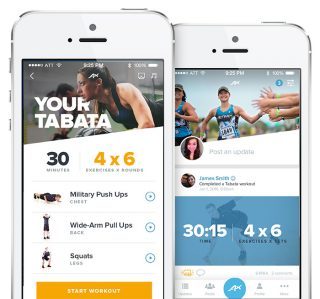
Workout apps have become the new gym. It’s convenient, you can do it within the comforts of your own home or on your own schedule, and it will even connect you to the community equivalent of a run club or group workout. Following this popularity of social-based workout apps—like Nike+ Running, Runkeeper and Strava—Active, primarily an endurance sports event listings site, is releasing its own app today called ACTIVEx.
RELATED: 7 Great Apps to Track Your Running Data
The unique idea behind ACTIVEx is the user’s ability to create and/or find his or her own active community through building a “pack.” A pack could be one that you athletically identify with such as the “active moms” pack or one you create and organize yourself with a group of invited individuals. For example, you can create a “training for your first marathon” pack and have people join and hold each other accountable in this endeavor by tracking everyone’s progress through the app.
The app also includes tabata (or high intensity interval training) style workouts with video guidance and voice-based coaching. Plus, it expands to all sorts of fitness activities besides running, including swimming, cycling, strength training, etc.—completely catering to all your cross-training needs.
ACTIVEx is currently available for free through iTunes and on iPhone. However, the premium version will cost you $3.99, which includes unlimited access to customized tabata workouts and training plans for your first 5K, half marathon and ultra.
The post Active Launches New Social Workout App appeared first on Competitor.com.
7 Great Apps to Track Your Running Data
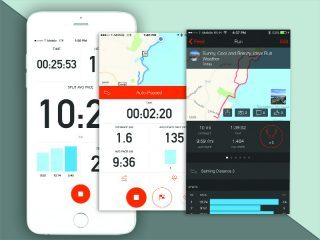
Developers have been hard at work trying to create the killer app for running. Most of the apps in this article give you the basics of pace, time, distance, music and audio cues. All allow linking to external heart rate sensors. With the increasing ability to share data across fitness platforms, the app that works best for you comes down to features and preferences.
Strava
Free ($6 per month for Premium)
iPhone and Android
Strava’s platform has become a de facto gathering place for running and cycling data and social interaction. Most other run apps and GPS watches can export to Strava. Its unique post-run focus is on sharing, comparing and rating performances along routes and segments. Strava’s premium service adds a highly visible, on-screen view with live performance stats from connected sensors, training programs, additional analysis of your workouts, and races along with age-based segment and route leaderboards.
Under Armour MapMyRun
Free ($5.99 per month for MVP version)
iPhone and Android
As the name implies, MapMyRun has long focused on routes: yours and others. Map a route upfront or import someone else’s—the app will tell you the distance. Then follow the route on the app. Travel a lot? The Route Genius will suggest routes near your location. The cleanly executed free version also gives you the ability to pair sensors including the Under Armour Speedform Gemini 2 Record Equipped shoe and UA scale. The MVP version adds audio coaching, interval training, live tracking and basic training plans.
Polar Beat
Free (paid upgrades available)
iPhone and Android
The free version covers the basics of pace, distance, time and mapping with a clean interface, clear audio cues and dozens of sports profiles. It shines when you add Polar’s HL7 BT heart rate strap or Stride Sensor ($79.99), the only sensors compatible with the app. We particularly liked the Benefit Target add-on ($2.99): Based on your heart rate zone ranges, it uses audio cues to direct you through six different workouts. Review and then relive your run, ride, or even ski session on an animated map with data, music and a few street views.
Runkeeper
Free ($9.99 per month for Go version)
iPhone and Android
ASICS recently acquired this elegantly designed, goal-oriented app, which offers all the basics free, plus the ability to build interval workouts and illustrate your runs with photos. Given its ease of use, it’s an ideal choice for beginners. The premium Runkeeper Go version includes training plans that adjust based on your training results, track your performance versus your goals and provide deeper data insights and comparisons.
iSmoothRun Pro
$5.99
iPhone only
iSmoothRun is the only app here with no free version. The entry fee gets you essentially all the features of a higher-end GPS run watch on your phone: broad sensor pairing, heart rate and pace zone alerts, a deep audio cued intervals module, cadence and metronome, along with the ability to see on-the-go stats on watch-based displays from Apple and others. Although there is no website for data, just a well-
executed log in the app, you can export your data to 16 of the most popular apps and platforms.
Suunto Movescount
Free
iPhone and Android
A free, basic app, Movescount has the unusual feature of allowing you to tap on the screen to change displayed metrics on the fly. There are no audio cues or auto pause but heart rate monitors can be paired to the app. Use it as your GPS run app (the back end platform is excellent) or run it simultaneously with your GPS watch. Movescount can create a 3D Suunto Movie of your run, with pictures taken along the way and key metrics presented in context as they occur in a beautiful shareable video.
Nike+ Running
Free
iPhone and Android
Entirely free, the Nike app covers all the basics and includes race based training plans along with a display on Apple Watch. The app and website will track total runs, average pace over time, and encourages you to compare and compete with yourself and others. Strongly focused on music, select free Spotify Nike+Run Club playlists by linking your Spotify Premium account to the app, even set “power songs.” It’s a great app choice for those with competitive instincts; it’s designed to motivate runners as they progress.
Tips & Tricks: How can I see or hear my workout stats?
Use an armband or carry your phone in your hand if you only want visual indications.
Stash your phone away if you want audio feedback or already listen to music. All the apps can tell you pace, time and other stats every mile or more frequently.
Many shorts now accommodate up to iPhone 6S size phones or use a fabric stretch belt with pockets. If your phone does not have a water-resistant case, always protect it from excessive sweat with a plastic bag.
Pair your app to a wrist display, verifying that your app supports the display.
The post 7 Great Apps to Track Your Running Data appeared first on Competitor.com.
Ryan Hall's Blog
- Ryan Hall's profile
- 21 followers



